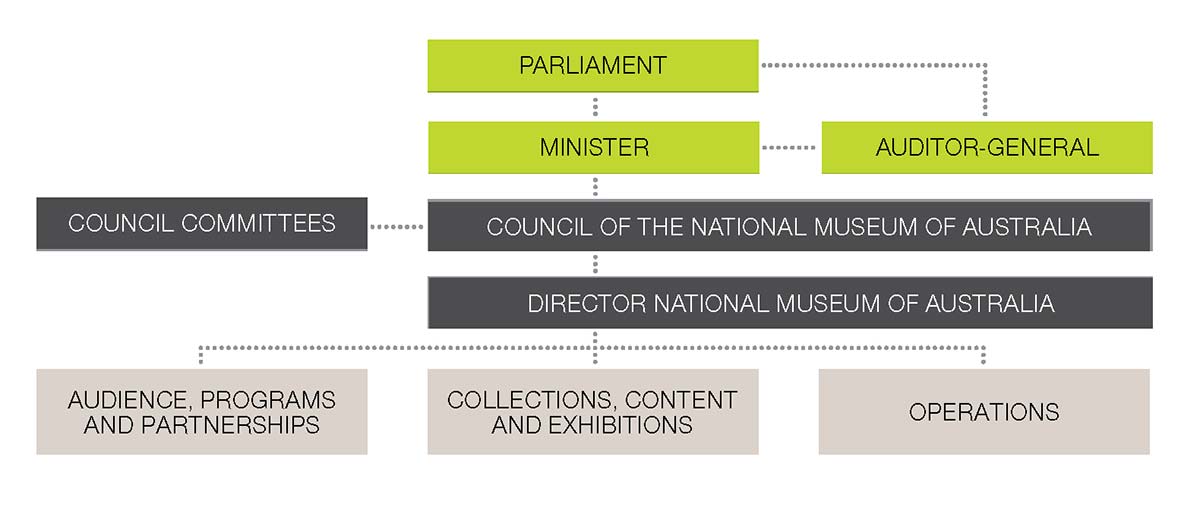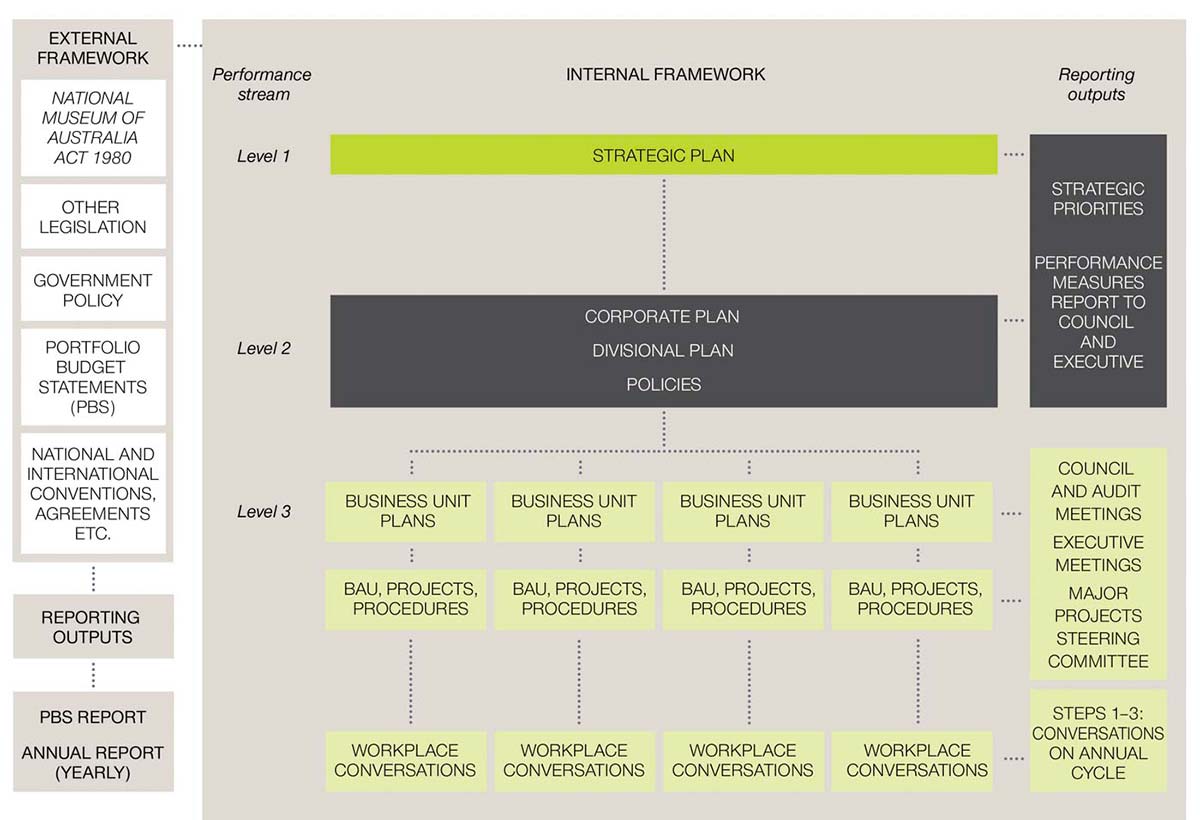The National Museum of Australia is a statutory authority. In 2014–15, the Museum sat within the Attorney-General’s portfolio. The minister responsible for the Museum is Senator the Hon George Brandis QC, Attorney-General and Minister for the Arts.
The Museum guides the delivery of its outputs through its corporate governance framework. This framework comprises the Museum’s enabling legislation and other legislative instruments, managerial and organisational structures, corporate policies and strategies, and resource management practices.
Legislation
The National Museum of Australia Act 1980 (the Museum Act) defines the broad functions and activities of the Museum. This Act established the Museum as a Commonwealth statutory authority and, along with the National Museum of Australia Regulations 2000, defines the Museum’s role, functions and powers. (See Appendix 2: Functions and powers of the National Museum of Australia.)
The primary piece of Commonwealth resource management legislation governing the Museum is the Public Governance, Performance and Accountability Act 2013. This Act establishes the guidelines of governance and accountability for public resources, with an emphasis on planning, performance and reporting. It also deals with the conduct of officers and states that directors are responsible for the preparation and content of the report of operations in accordance with the Commonwealth Authorities (Annual Reporting) Orders 2011. The Public Service Act 1999 covers the powers of the Director of the Museum in relation to the management of human resources.
Council and committees
The Council of the National Museum of Australia is responsible for the overall performance of the organisation, including setting the strategic direction and establishing goals for management. The Council works with executive management in developing, executing, monitoring and adjusting the appropriate strategies, and its members are appointed under Section 13(2) of the Museum Act.
The Act provides for a Council consisting of a Chair, the Director of the Museum and between seven and 10 other members. All members are appointed by the Governor-General and, apart from the Director, are part-time appointees for terms of up to three years, although terms of appointment can be extended. The Director can hold office for a period not exceeding seven years.
The current membership of the Council provides a mix of skills and experience in the areas of history, law, education, the arts, media, Indigenous issues, marketing, business, and financial and strategic management.
The Commonwealth Remuneration Tribunal determines remuneration for non-executive members. At 30 June 2015, the Council comprised the following non-executive members:
Mr David Jones (Chair) is Executive Chairman of VGI Partners and Executive Director of Kudos Energy. He was previously executive director at Better Place Australia, having been in private equity for 17 years. He is a non-executive director of four other organisations: Derwent Executive (Chairman), Global Sources Limited, EMR Capital and EC Group.
Dr Janet Albrechtsen is an opinion columnist with the Australian, and has written for the Wall Street Journal, Australian Financial Review, Age, Sydney Morning Herald, Canada’s National Post and Vancouver Sun. She is Director of the board of the Institute of Public Affairs, an ambassador and mentor with the Australian Indigenous Education Fund, a member of the ABC and SBS Appointments Panel, and was a member of the Australian Broadcasting Corporation Board. Prior to turning to commentary, she worked as a solicitor in commercial law at Freehill, Hollingdale and Page and taught at the University of Sydney Law School.
Mr Nicholas Davie is the founder of a number of data analytics and marketing companies, including Centrifuge42 and Brand Communities. He is the former chief executive officer of the marketing and advertising company Publicis Mojo. Mr Davie is currently a member of the Board of Trustees of the Sport and Tourism Youth Foundation, and is also one of the founders and the Co-chair of the children’s charity, the Bestest Foundation.
Professor Rae Frances is Dean of Arts and Professor of History at Monash University. She has an extensive record of teaching, research and publication in Australian social history and is the recipient of numerous national awards and prizes for her teaching and publications. She is the chair of the Board of the Australian Intercultural Society and a Fellow of the Academy of Social Sciences in Australia.
Mr Alex Hartman is an entrepreneur, Executive Chairman of Newzulu Limited and co-founder and Executive Vice-President of Matilda Media Pty Ltd. He is involved in public health services for young people and has served as a member of the Australian Industry Research and Development Board, director of the Australian Business Foundation Limited, Advisory Board member of Headspace and ambassador of the Sony Foundation. Mr Hartman won the Young Australian of the Year Award for Career Achievement in 2001. He studied law at the University of Technology, Sydney.
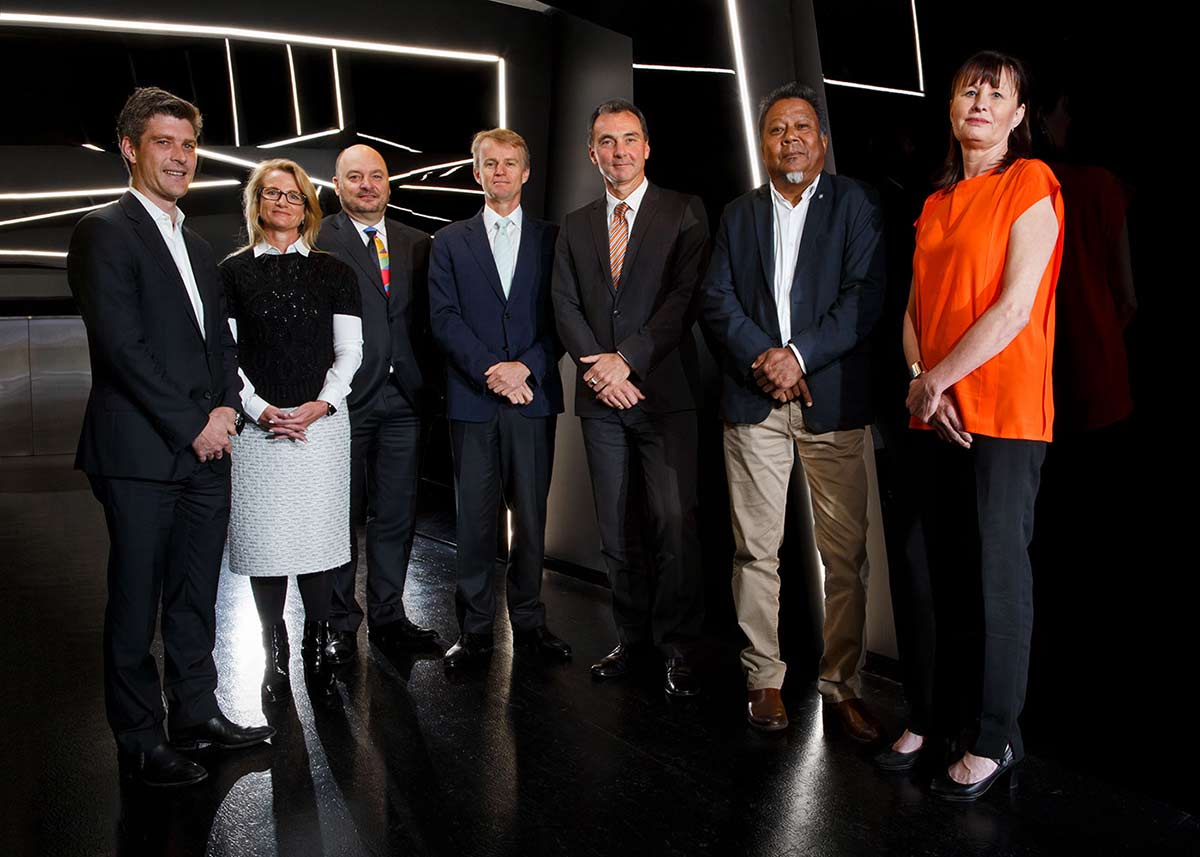
Professor Catharine Lumby is Professor of Media at Macquarie University where her research spans media studies, gender studies and media content regulation. Since 2004, she has worked in a pro-bono role advising the National Rugby League on cultural change and education programs for players. Before entering academia in 2000, she was a journalist and opinion writer and has worked for the Sydney Morning Herald, the Australian Broadcasting Corporation and the Bulletin magazine.
Mr Peter Yu is a Yawuru man from Broome, Western Australia. He is Chair of North Australian Indigenous Land and Sea Management Alliance Ltd, Deputy Chair of Broome Future Ltd, Deputy Chair of AFL Aboriginal Advisory Committee and a Director of the Yawuru PBC (Prescribed Body Corporate).
The Museum Council held five meetings during 2014–15. A senior executive staff officer from the Ministry for the Arts attended three meetings as an observer.
The Museum provides Council members with information on changes to corporate governance responsibilities as it becomes available, including Australian National Audit Office documents and guidelines.
The Council has policy and procedures for the disclosure and resolution of any matter for its consideration that may result in a conflict of interest. Members are required to make the nature of that interest known at the commencement of a Council meeting, and details of such disclosures are recorded in the minutes of the meeting.
The Council has established an Audit, Finance and Risk Committee to assist in the execution of its responsibilities, and an Indigenous Reference Group to advise on sensitivities and protocols relating to Aboriginal and Torres Strait Islander exhibitions and other relevant matters. Details of Council and committee meetings are listed in Appendix 1.
Executive management group
The executive management group, comprising the Director, two Assistant Directors and the Chief Operating Officer, provides strategic and operational leadership to the Museum.
Dr Mathew Trinca, Director
Dr Mathew Trinca was appointed Director of the National Museum of Australia in February 2014. His current term of appointment is for a period of five years. Dr Trinca was the Acting Director of the National Museum from 2 July 2013. Before that time he was the Museum’s Assistant Director, Collections, Content and Exhibitions, with responsibility for collections acquisition, management and preservation, redevelopment of permanent galleries, temporary and travelling exhibitions, and curatorial and research activities. Dr Trinca has published papers on the history of Australian travel to London and on museums and their meaning, and has co-edited two books, Country: Visions of Land and People in Western Australia and Under Suspicion: Citizenship and Internment in Australia during the Second World War. He is the secretary of Museums Australia’s National Council Executive.
Ms Helen Kon, Assistant Director, Audience, Programs and Partnerships
Helen Kon joined the Museum in 2011 after working in senior management positions at the National Library of Australia and the State Library of New South Wales. Ms Kon has managed education and public programs, communications and marketing, digital and print publishing, commercial operations, development, membership programs, volunteers, visitor services and exhibitions. Prior to working in the cultural sector, Ms Kon was education services manager in marketing at the Age newspaper. Her wider professional contributions have included membership and chairing of a number of national and state committees, boards and professional associations across the cultural and education sectors. Ms Kon chairs the Museum Friends Advisory Committee and is currently the chair of the Public Programs Working Group for the National Collecting Institutions.
Dr Janda Gooding, Assistant Director, Collections, Content and Exhibitions
Dr Janda Gooding was appointed Assistant Director, Collections, Content and Exhibitions at the National Museum of Australia in August 2014. Previously, she worked at the Australian War Memorial from 2005 to 2014. She worked at the Art Gallery of Western Australia from 1979 to 2005, where she curated many thematic, retrospective and survey exhibitions of Australian and international artists. Dr Gooding has a PhD in history from Curtin University, and a degree in Fine Arts and a Master of Philosophy in Australian Studies from the University of Western Australia. She has written extensively on Australian social and cultural history, and art history. More recently, she has contributed book chapters to publications on photography and digital technologies, and Thomas Baines and the Augustus Gregory expedition of 1855 to 1857. Dr Gooding has authored several exhibition catalogues and books including: Gallipoli Revisited: In the Footsteps of Charles Bean and the Australian Historical Mission and Brush with Gondwana: The Botanical Artists Group, Western Australia.
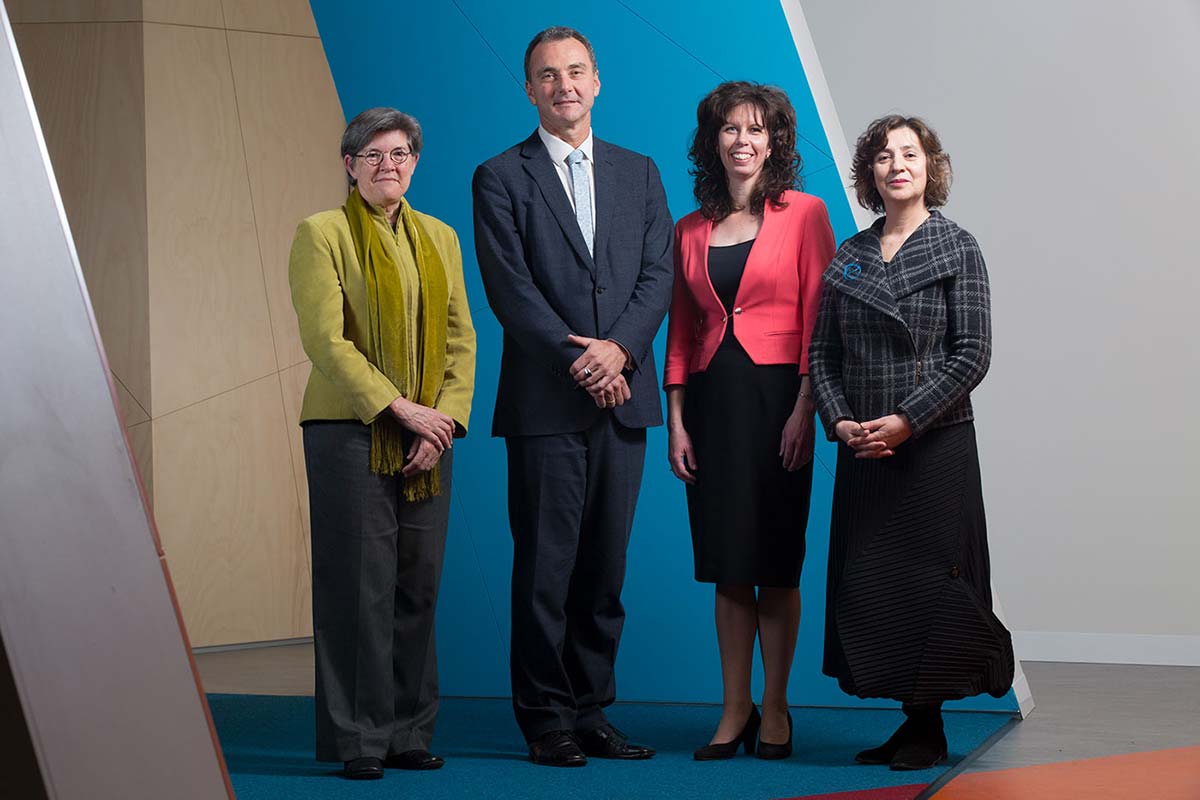
Ms Stephanie Bull, Acting Chief Operating Officer
Stephanie Bull joined the Museum in 2004, initially managing the Museum’s exhibitions and gallery redevelopment program before moving into the field of international exhibitions and partnerships. In recent years, she has managed the Museum’s governance program, overseeing business planning, reporting and performance. Ms Bull worked at the Australian War Memorial for eight years in gallery redevelopment, and commenced her public sector career in the Department of Defence. She has a BA (Hons) in Australian history.
National Museum of Australia organisation chart as at 30 June 2015
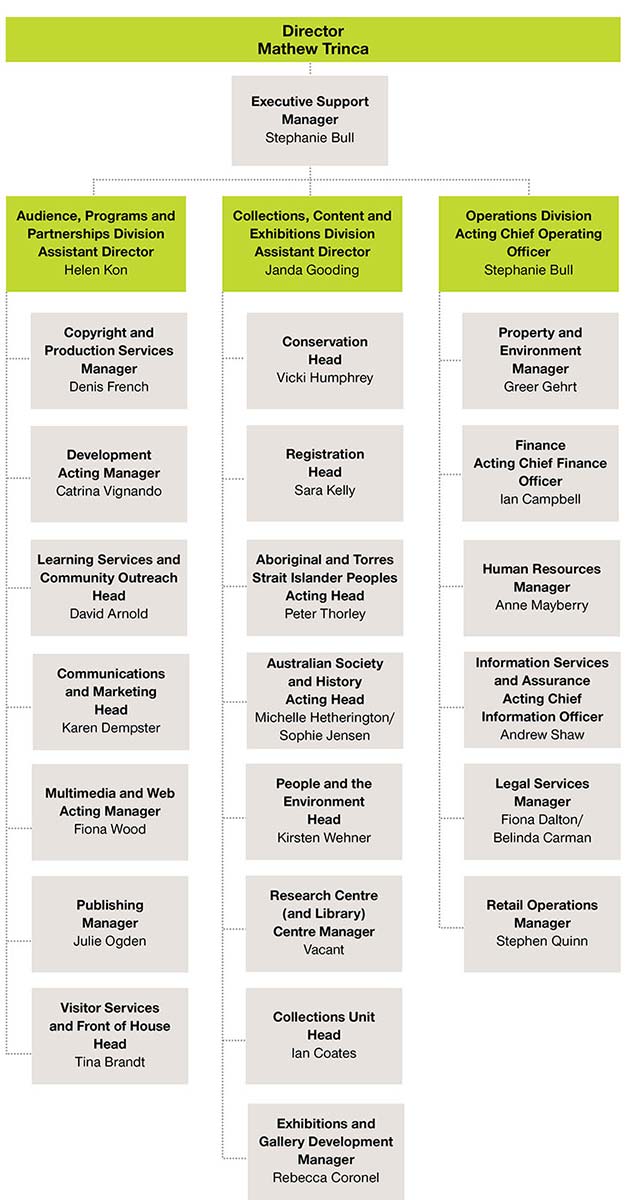
Performance Management Framework
The Museum’s organisational Performance Management Framework provides the structure for delivering outputs and outcomes through planning, policy and procedural work. Performance is guided by the Museum’s strategic, corporate, divisional and business plans. Performance is monitored by quantitative measures, project management practices and qualitative reports.
The Museum reports its performance to government and other external interests through the Annual Report and the Portfolio Budget Statements.
Strategic priorities
The Museum reports to Council each quarter against its strategic priorities and corporate plan. The corporate plan identifies the Museum’s business focus for the year, and measures outcomes and performance against each output. This ensures that accountability of performance is carried out across the organisation. The key priorities and corporate plan outputs are reported against in Part One: Executive summary — Achievement of strategic and business priorities.
Business planning
Business planning is central to the Museum’s delivery of outcomes and outputs for its stakeholders. Museum business units implement annual business plans that are linked to the Museum’s strategic plan, the corporate plan, business priorities and budgets. Business planning identifies key risks and risk mitigation for the delivery of these priorities.
Project management
The Museum operates a project management system to deliver large-scale projects and programs. The Major Projects Steering Committee oversees all large-scale projects at the Museum. The framework includes a suite of documentation that ensures projects are well-defined, responsibilities are identified, business planning phases are undertaken, and accountability and risk management policies and guidelines are followed.
Policies and plans
The Museum has a comprehensive suite of policies and plans. These are monitored and reviewed at regular intervals and made publicly available on the Museum’s website.
Internal and external scrutiny
Internal audit
Synergy Group Australia Ltd, the Museum’s internal audit service provider, has maintained a focus on ensuring the completion of prior audit outcomes, the delivery of value-adding services and completion of the Strategic Internal Audit Plan for 2014–15. Activities included the following five compliance and performance audits:
- a review of the management of the implementation of the Public Governance, Performance and Accountability Act 2013 (PGPA Act)
- a gap analysis of the Museum’s information and physical security policy and procedures, in reference to the Protective Security Policy Framework
- a review of the Museum’s enterprise risk framework
- a review of the Museum’s framework and processes for planning, developing, delivery and evaluation of exhibitions
- a review of contract management for the Museum’s cafe operations.
Reviews for 2015–16 are in the approved Strategic Internal Audit Plan for 2015–16. The Strategic Internal Audit Plan 2015–18 includes a review of internal audits undertaken in the past five years to ensure a consistent long-term approach to internal audit activities.
External audit
The Australian National Audit Office is responsible for auditing the Museum’s annual financial statements. An unqualified audit opinion precedes the annual financial statements in Part Four of this report — Audited financial statements.
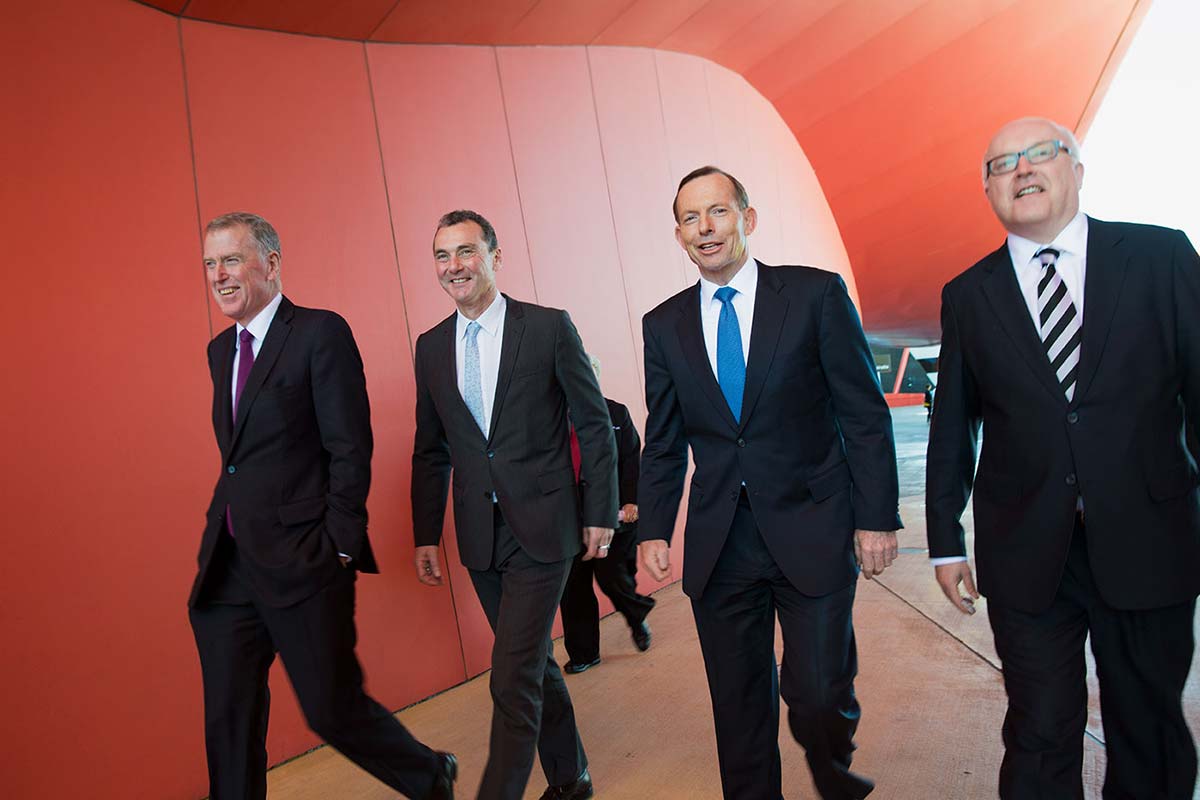
Risk management
The Museum has implemented an Enterprise Risk Management Framework, based on the International Standard on Risk Management, ISO 31000:2009.
Enterprise risk management is a process that is effected by Council, the Executive and Museum staff, and applied in strategy setting across the whole of the Museum. It is designed to identify and manage risk and to provide reasonable assurance regarding the achievement of the Museum’s objectives, while embracing new ideas, programs and projects that stimulate public engagement in Australia’s history.
The Museum’s Enterprise Risk Management Framework focuses on risk under the following categories: compliance, health and safety, performance, financial risk, reputation, capability (skills and resources), and environmental and social responsibility.
The Museum’s executive management group reviews the key enterprise risks on a monthly basis. This ensures transparency of enterprise risks, which are subsequently discussed with the Audit, Finance and Risk Committee.
The Museum continues to participate in Comcover’s annual Risk Management Benchmarking program.
Fraud control
The Museum has in place fraud prevention, detection, investigation, reporting and data collection procedures and processes that, together with the Fraud Risk Assessment and Control Plan, meet the specific needs of the Museum and ensure compliance with the Commonwealth Fraud Control Guidelines.
The Museum’s Fraud Risk Assessment and Control Plan is endorsed by Council and reviewed every two years. The next review is to be conducted in September 2015. Fraud is reported as a standing item to the Audit, Finance and Risk Committee. There have been no reported instances of fraud at the Museum during 2014–15.
Fraud awareness training is provided to all staff as part of their induction and ongoing general awareness training.
Freedom of information
Part 2 of the Freedom of Information Act 1982 (FOI Act) established an Information Publication Scheme (IPS). The Museum is subject to the FOI Act and is required to comply with the IPS requirements.
In accordance with the IPS, the Museum is required to:
- publish an agency plan
- publish specified categories of information
- consider proactively publishing other government information
- publish this information (or details of how to access it) on a website.
There were two requests for access to documents under Section 15 of the FOI Act during 2014–15. Details of the Museum’s compliance with the IPS requirements during 2014–15 are available in Appendix 4: Freedom of information
Privacy legislation
No reports by the Privacy Commissioner under Section 30 of the Privacy Act 1988 concerning actions or practices by the Museum were received during 2014–15.
Formal decisions/notifications/ministerial directions
The Museum received no formal notifications or ministerial directions from the Minister for Finance during 2014–15.
There have been no government policy orders made by the Finance Minister applying to the Museum under Section 22 of the PGPA Act.
Significant events, judicial decisions and particulars of reports
The Museum did not advise the Minister of any significant decisions or issues during 2014–15, in accordance with the PGPA Act. There have been no judicial decisions or decisions of administrative tribunals that have had, or might have, a significant effect on the operations of the Museum. There have been no amendments to legislation that affect the operation or structure of the Museum.
No reports about the Museum were made by the Auditor-General, a Parliamentary committee, the Commonwealth Ombudsman, the Privacy Commissioner or the Office of the Australian Information Commissioner.
Legal actions
In 2014–15 the Museum did not settle any claims as a result of any legal action.
Ombudsman
No issues or matters about the Museum were referred to, or raised with, the Commonwealth Ombudsman.
